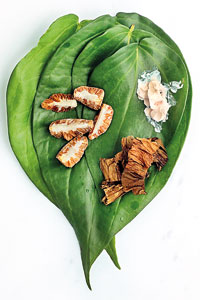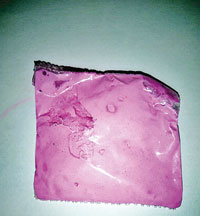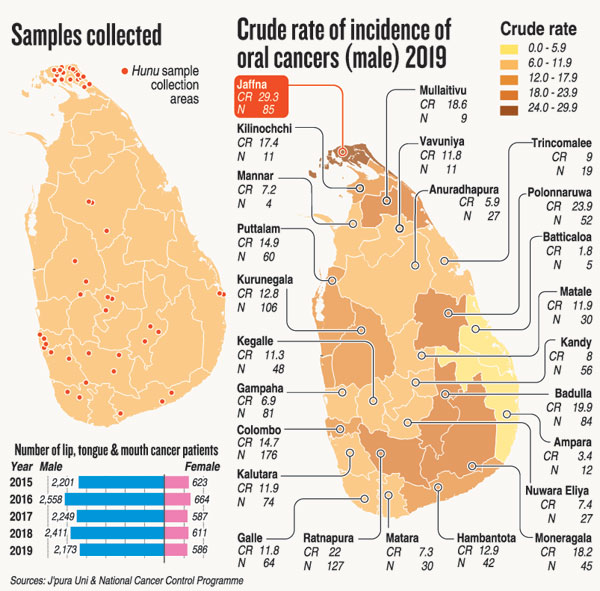News
Alarm bells over toxic textile dye found in betel chewing hunu
View(s):- Finding comes to light during a study on oral cancer
By Kumudini Hettiarachchi
It should be white but it was a mutai pink, bringing with it double jeopardy!
An analysis of the pink pigment gave a chilling insight – it was due to Rhodamine B, a toxic textile dye, which is banned against use as a food colouring agent.
The pink hunu (slaked lime or Calcium carbonate) from the Jaffna peninsula had puzzled a research team from the Sri Jayewardenepura University’s Faculties of Medical Sciences; Applied Sciences; and Allied Health Sciences, as they pored over samples sent from different parts of the country.
 Dr. Sajith Edirisinghe |  Senior Prof. SurangiYasawardene |  Senior Prof. Pradeep Jayaweera | ||
 Prof. Manjula Weerasekara |  Hashan Priyanath |

The usual vita eaten elsewhere in the country. Pic by M.A. Pushpa Kumara
The study was on betel chewing (vita kaema) and how injurious to health it could be, with the samples from the Jaffna peninsula being clearly different to those from other areas of the country.
Betel chewing entails popping into the mouth a betel leaf wrapped around a piece of areca-nut, tobacco and hunu. The concoction is then chewed for hours before being spat out.
“Oral cancer (mouth cancer or cancer of the oral cavity) is the topmost cancer (No. 1) among men in Sri Lanka,” says study team member and Senior Lecturer in Anatomy at the Faculty of Medical Sceinces, Dr. Sajith Edirisinghe.
The other team members were: Senior Professor of Anatomy, Senior Prof. Surangi Yasawardene & Professor in Microbiology, Prof. Manjula Weerasekara from the Faculty of Medical Sciences; Senior Professor in Chemistry, Faculty of Applied Sciences, Senior Prof. Pradeep Jayaweera; and research student, Faculty of Allied Health Sciences, Hashan Priyanath.

laked lime sample from Jaffna
Dr. Edirisinghe said that usually betel nut chewing is seen as the main culprit causing Oral Submucous Fibrosis (OSF). This is the thickening or scarring of mouth tissue which brings about pre-cancerous lesions (an area of abnormal tissue).
According to data from the National Cancer Control Programme in 2019 (the latest data available), 2,173 men and 586 women were ‘newly-diagnosed’ with oral cancer which involves the lips, tongue or buccal mucosa (the inner lining of the cheeks).
“The Jaffna peninsula accounts for the most number of patients when taking into account those affected by oral cancer,” says Dr. Edirisinghe, explaining that they collected 50 samples on January 14 between 8 a.m. and 3 p.m. from across the country for their study.
There was a distinct difference between those from outside the Jaffna peninsula and those from within the peninsula – all of the 18 samples from the peninsula collected from different points were a bright pink, while the rest from other parts of the country were white as was expected.

| CAA is investigating The study team has not kept their research gathering dust on a shelf but handed over a report titled ‘Detection of Rhodamine B in slaked lime samples in Jaffna district – Potential causative agent in increasingoral cancer risk’ to the relevant authorities. “Conduct an impartial investigation by the Government Analyst and take necessary action to prevent the addition of Rhodamine B as a colouring agent with immediate effect,” is the fervent appeal of the team. The report had been handed over to the Ministry of Consumer Affairs Authority (CAA) on March 30. When contacted by the Sunday Times a CAA source said that several samples of the slaked lime had been sent to the Industrial Technology Institute (ITI) for analysis. The report is expected next week. Meanwhile, Dr. Sajith Edirisinghe said that Rhodamine B belongs to the family of chemical compounds used as textile dyes because of its good stability. It is an organochlorine (a chemical containing chlorine and carbon) derivative. “Organochlorines are chemically classified as insecticides that have low toxicity but can persist in the environment and accumulate in tissues through food,” he said, underscoring that Rhodamine B is not in the list of synthetic dyes which are permitted to be used as a colouring substance in food under the Food Act 26 of 1980. A scientific literature search by the team on the health risks and hazards of Rhodamine B had found that: This textile dye, Rhodamine B, is toxic to the human body. It often enters the body when mixed with food, thereby causing oxidative stress on cells and tissues. The use of Rhodamine B in food for a long time leads to liver dysfunction or cancer and when exposed to large amounts over a short period, it results in acute Rhodamine B had been bannedin Taiwan in 2017. The administration of Rhodamine B may decrease the number of primary follicles in white rat ovaries and is a contributor in the incidence of infertility disorder. | |
The best way to say that you found the home of your dreams is by finding it on Hitad.lk. We have listings for apartments for sale or rent in Sri Lanka, no matter what locale you're looking for! Whether you live in Colombo, Galle, Kandy, Matara, Jaffna and more - we've got them all!

